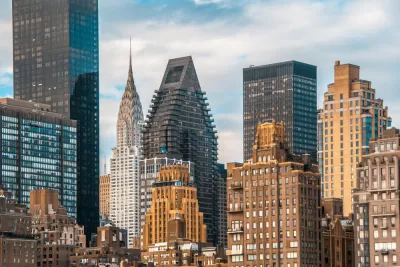Planopedia
Clear, accessible definitions for common urban planning terms.
What Are Height Limits?
Height limits are a critical component of almost every zoning code in the United States.

Height limits are a regulatory control on development found in the zoning codes of almost every city in the United States. Zoning codes regulate the height of new buildings depending specifically on geographic area as well as development types and land uses.
Height limits set the upper boundary of the building envelope for a given zone or parcel (the building envelope is a conceptual term that describes the maximum extent of development allowed by the zoning code). To determine the height limit, most zoning codes measure the vertical distance between the average graded ground level at the sides of the proposed building and the elevation of the roof. The height limit measurement can be understandably complicated on uneven hillside properties, or when the roof design calls for a pitched roof or other design features. Each zoning code will include specific, targeted metrics for addressing those conditions.
Height limits are typically justified for the following reasons:
- Protection from fire hazards.
- Protection against aviation accidents.
- Protection of view.
- Protection of the character of the neighborhood.
- Protection of light and air
Some cities will also set height limits for new buildings to preserve the prominence of an older building or a government landmark. For example, in the Russian capital of Saint Petersburg, the height of new buildings could not be taller than the Winter Palace for 200 years of the city's history. A similar history can also be found in Los Angeles, where City Hall was allowed to exceed the city's height limits when completed in 1928—the only exception to a rule that stayed in place until the 1960s.
Step-backs
Height limits will sometimes allow an important exception that creates opportunities for additional building height: step-backs. Step-backs allow for a tiered design at the upper levels of a building. Thus, height limits often prescribe different height limits at the outer limits of buildable areas compared to height limits set over the central portion of a buildable area.
Step-backs are thus a form of architectural compromise, allowing building developers additional height, density, and intensity, while prescribing specific building design features intended to reduce the visible scale of buildings while also emphasizing the ground-level elements of buildings. Step-backs are also deployed to limit the impacts of buildings on smaller neighboring structures, maintain a consistent character of size and design throughout neighborhoods, allow more space for light and air, and maintain views of surrounding areas.
Height Limit Controversies and Criticisms
Height limits are frequent sources of contention and controversy during development approval processes and planning and zoning processes, because height limits are a key factor in determining the number of stories a building can contain. Combined with measures of density (like dwelling unit per acre) and development intensity (like floor-area ratio and minimum lot size), height limits are a specific and frequent flashpoint for debates between pro-growth and anti-development political forces.
Institutional sources in the field of planning have debated the application of height limits by zoning codes in the United States. Planning literature from the 1960s describes the application of height limits in zoning codes as "arbitrarily selected figures without any clear relation to specific purpose."
The same document also calls attention to one of the most frequent sources of controversy regarding the height of buildings: the effect on light and air. "Present regulatory patterns are not only crude but almost dishonest if protection of light and air is of equal importance for everyone, and if this is a principal purpose of height and yard combinations." To the present day, development opponents will cite the blocking of the sun as a reason to limit the height of new buildings through regulatory means.
In the United States, the capital city of Washington, D.C. provides perhaps the most cogent example of the controversies that height limits can create. Because of its unique legal standing, D.C. height limits have been set by Congress, first by the Height of Buildings Act of 1899 and then later amended by the Height of Buildings Act of 1910. Thus, on the repeated occasion that local interests seek changes to the District's famously restrictive height limits, they must be granted approval by the federal government.
In 2014, a debate over height limits even created a controversy among ostensibly pro-development pundits. Charles Marohn wrote on his advocacy site Strong Towns that too-high height limits also artificially inflate the value of land, thus making development in many places too expensive. Marohn argued in favor of setting height limits at increments of growth, to ensure that the development market matches planning ambition and that development happens in stages.
In a reply to Marohn's argument, Alon Levy argued that such an incremental approach would necessitate the repeated buying out of existing developments, which is "a recipe for high marginal costs."






























